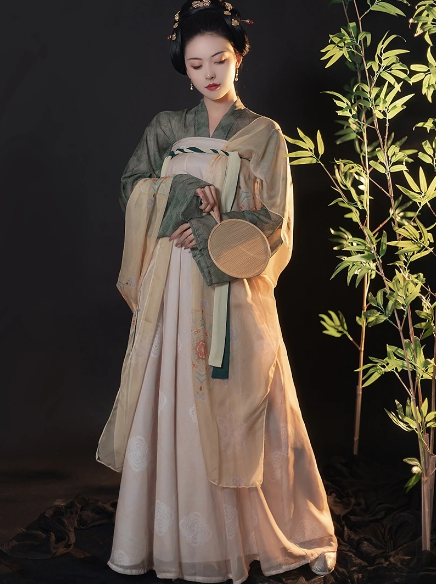To care for silk hanfu jackets, gently clean, avoid direct sunlight, and store in a cool, dry place.
Understanding Silk Fabric
Silk, a luxurious and highly sought-after material, boasts a history as rich and varied as its texture. Cultivated from the cocoons of the mulberry silkworm, this natural fiber stands out for its sheen, softness, and enduring strength. Silk’s unique properties not only contribute to its aesthetic appeal but also its versatility in fashion and home décor. The process of silk production, known as sericulture, involves a meticulous and labor-intensive method, ensuring the fiber’s premium quality and value.
Properties of Silk
Silk shines as a remarkably strong fabric, capable of withstanding great tension before breaking. This resilience, paired with its natural protein structure, gives silk a smooth and soft texture that is gentle against the skin. Its thermoregulatory properties allow it to keep the wearer warm in winter and cool in summer, making silk an ideal choice for clothing across different climates. Silk’s natural luster, stemming from its triangular prism-like structure, reflects light at various angles, creating a captivating sheen.
Another noteworthy characteristic of silk is its absorbency. Silk can absorb up to one-third of its weight in moisture without feeling damp, ensuring comfort for the wearer in various conditions. Despite its delicate appearance, silk exhibits good resistance to deformation and creases, maintaining its elegant drape and form over time.

Why Silk Requires Special Care
Silk’s distinct qualities necessitate specific care to maintain its beauty and longevity. The protein-based fibers of silk are susceptible to damage from harsh chemicals and rough handling, making it imperative to adopt gentle cleaning and maintenance techniques. Unlike synthetic fabrics, silk can lose its strength when wet and can be easily damaged by high temperatures and direct sunlight.
The delicate nature of silk also makes it prone to water spotting and requires a careful approach to stain removal to avoid permanent discoloration. Preserving the fabric’s natural sheen and texture calls for a nuanced understanding of silk care, from selecting appropriate detergents to mastering the correct drying techniques. Given silk’s premium value and the intricate process of its production, investing time and effort in its proper care ensures that silk garments and items can be cherished and enjoyed for years to come.
Incorporating these insights into the routine care of silk items, especially silk hanfu jackets, guarantees that the material’s luxurious feel and exquisite appearance remain intact, providing endless enjoyment and wear. By respecting silk’s unique needs and characteristics, owners can ensure their silk garments remain a timeless addition to their wardrobe, embodying elegance and sophistication.
Routine Care and Maintenance
Caring for silk hanfu jackets requires a meticulous approach, emphasizing gentle handling and strategic maintenance to safeguard their elegance and durability. This fabric, renowned for its delicate beauty and luxurious feel, thrives under attentive care, ensuring it remains a staple of sophistication in any collection.
Daily Handling and Storage
Silk hanfu jackets demand careful handling to maintain their pristine condition. It’s essential to pick up these garments by the body rather than the sleeves or edges to prevent stretching or distortion. When wearing silk, one must be mindful to avoid any rough surfaces or sharp jewelry that could potentially snag or pierce the fabric, compromising its integrity.
For optimal storage, placing silk garments on padded hangers is key, as this helps to retain their shape and avoid the formation of creases or wrinkles. Ensuring there is ample space in the closet allows silk to “breathe,” preventing pressure marks or damage from adjacent clothing. To combat humidity, a common threat to silk’s freshness, incorporating silica gel packets in the closet works wonders in absorbing moisture, thus thwarting mildew and odor.
Light exposure, particularly direct sunlight, poses a risk to silk, leading to color fading and fiber weakening over time. Thus, a dark, cool storage environment is paramount. For extended storage periods, wrapping silk items in acid-free tissue and using a breathable garment bag can prevent yellowing and deter pests, preserving the fabric’s vibrancy and texture.
Preventing Wrinkles and Damage
To prevent wrinkles, a critical aspect of silk care, avoiding tight folding or harsh creasing is advisable. Rolling silk garments gently for temporary storage or travel minimizes the risk of crease formation. In the event of wrinkles, utilizing a steamer at a low setting can effectively remove them without inflicting heat damage. When ironing is necessary, employing a pressing cloth and setting the iron to the lowest heat ensures the fabric’s safety.
Immediate action on spills and stains is crucial to prevent lasting damage. Gently blotting the affected area with a clean, dry cloth can remove excess liquid without spreading the stain. For spot cleaning, opting for specialized silk detergents or mild, pH-neutral soaps—and conducting a patch test for colorfastness—can mitigate the risk of altering the fabric’s appearance.
Regular inspections for wear or damage facilitate timely interventions, such as reinforcing seams or repairing minor tears, preventing further deterioration. For more significant repairs, seeking professional services offers the expertise needed to handle delicate silk without causing additional damage.
Adhering to these care guidelines ensures silk hanfu jackets retain their allure and strength, embodying timeless elegance and cultural depth. Through conscientious handling, strategic storage, and preventive measures against wrinkles and damage, these garments can continue to enhance wardrobes with their unique blend of comfort, style, and sophistication, making every effort in their maintenance well worth it.
Cleaning Silk Hanfu Jackets
Spot Cleaning Techniques
When addressing spills or stains on silk hanfu jackets, prompt and careful spot cleaning can prevent permanent damage. Blotting the stain gently with a soft, absorbent cloth is the first step, avoiding the temptation to rub, as this can spread the stain or damage the fabric’s surface. For oil-based stains, applying a small amount of talcum powder before gently brushing it away can lift the oil without wetting the fabric.
For more stubborn stains, a solution of lukewarm water mixed with a few drops of mild detergent suitable for silk can be used. It’s crucial to test this solution on an inconspicuous area of the garment first to ensure it doesn’t affect the silk’s color or texture. Using a soft, white cloth, apply the solution to the stain with light dabs, then rinse the area with cold water, ensuring no soap residue remains.
Hand Washing vs. Dry Cleaning
Deciding between hand washing and dry cleaning silk hanfu jackets hinges on the garment’s specific care instructions and the nature of any stains or soil. Hand washing is often preferred for less severe stains or when the garment is labeled safe for water. This method involves using lukewarm water and a silk-friendly detergent, gently agitating the fabric with one’s hands, then rinsing thoroughly with cold water.
Dry cleaning, on the other hand, is advisable for silk garments with intricate designs, heavy stains, or when the care label specifically recommends it. Professional dry cleaners possess the expertise and equipment to clean silk garments without risking damage to their texture or color. However, frequent dry cleaning can be harsh on silk, so it’s best reserved for occasional or deep cleaning needs.
Drying and Ironing Tips
Drying silk hanfu jackets correctly is paramount to maintaining their appearance and longevity. Avoid wringing or twisting the fabric to remove water, as this can cause wrinkles and damage the fibers. Instead, lay the garment flat on a clean, dry towel, rolling it up gently to absorb excess moisture, then unroll and lay it flat to air dry away from direct sunlight and heat sources.
Ironing silk requires a gentle touch and the correct temperature setting. Always use the silk setting on your iron, and place a pressing cloth between the iron and the silk fabric to prevent direct contact. Ironing silk while it is slightly damp can make the process easier and prevent overheating, which can scorch or discolor the fabric.
By adhering to these detailed cleaning and maintenance practices, owners of silk hanfu jackets can ensure their garments remain in excellent condition. Spot cleaning, choosing the appropriate washing method, and following proper drying and ironing techniques are all critical steps in preserving the unique beauty and delicate texture of silk, allowing these traditional garments to be worn and cherished for years to come.

Advanced Preservation Techniques
Dealing with Stubborn Stains
When confronting stubborn stains on silk, a precise and patient method is essential. Pre-treating stains with a mixture of lukewarm water and a mild, silk-safe detergent can loosen most stains. For protein-based stains like blood, a solution containing a small amount of ammonia enhances the stain removal process, while white vinegar diluted with water can address deodorant and perspiration stains. It’s crucial to apply these solutions gently, using a soft sponge or cloth, and to always perform a patch test on a hidden section of the garment to ensure the treatment won’t damage the fabric or alter its color.
For the most stubborn stains, consulting a professional dry cleaner who specializes in silk can be the safest option. These experts use techniques and solvents that are specifically designed for delicate fabrics, ensuring the stain is removed without compromising the garment’s integrity.
Repairing Tears and Snags
Repairing tears and snags in silk hanfu jackets requires a delicate touch and the right tools. For minor snags, using a needle to gently work the snagged thread back into the fabric can effectively conceal the flaw without leaving a mark. Larger tears, however, may need a more intricate approach, such as silk patching or darning. This process involves using a matching silk thread to sew a patch or darn the tear, carefully mimicking the fabric’s weave to make the repair as invisible as possible.
In cases where the tear is too significant for home repairs, seeking the services of a professional tailor who has experience with silk can ensure the repair is done correctly. These experts have the skills to restore the garment to its original condition, often incorporating techniques that reinforce the area around the tear to prevent future damage.
Long-Term Storage Solutions
For long-term storage, preserving the quality of silk hanfu jackets involves several key considerations. Using acid-free tissue paper to wrap the garment helps prevent yellowing and fiber breakdown. The jacket should then be placed in a breathable garment bag, ideally made from a natural fabric like cotton, to protect it from dust, moisture, and pests without trapping humidity.
Storing silk garments in a cool, dry, and dark environment prevents degradation from temperature fluctuations and light exposure. Cedar balls or lavender sachets can offer natural protection against moths and other insects, but they should never come into direct contact with the fabric to avoid oil stains.
For those with valuable or antique silk garments, investing in a professional preservation service can be worthwhile. These services typically involve cleaning and preparing the garment for storage, then sealing it in an archival-quality box or container that provides optimal protection against the elements.
By employing these advanced preservation techniques, owners of silk hanfu jackets can ensure their garments remain in impeccable condition for years to come. Whether dealing with stubborn stains, repairing damage, or preparing for long-term storage, a careful and informed approach is key to maintaining the beauty and value of these exquisite pieces.